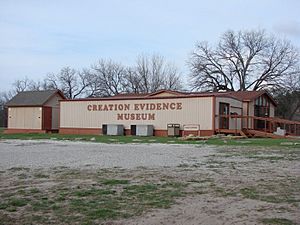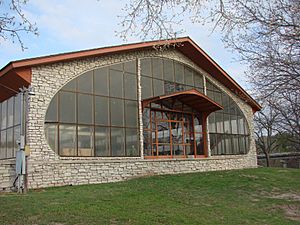Creation Evidence Museum facts for kids
The Creation Evidence Museum of Texas is a museum in Glen Rose, Texas that supports the idea of creationism. This means it teaches that the Earth is very young, about six thousand years old. It also suggests that humans lived at the same time as dinosaurs. This view is different from what most scientists believe, which is that the Earth is about 4.5 billion years old and dinosaurs died out long before humans appeared.
The museum was started in 1984 by Carl Baugh. Its main goal is to research and show exhibits that support creationism.
Contents
History of the Museum
How the Museum Started
Carl Baugh, who believes in a young Earth, came to Glen Rose in 1982. He wanted to study claims that human footprints were found next to dinosaur footprints. These prints were supposedly in the limestone banks of the Paluxy River, near Dinosaur Valley State Park.
Baugh says he found many dinosaur footprints and human footprints. These findings became the main reason for starting the Creation Evidence Museum. Carl Baugh is still the director of the museum.
Museum Projects and Ideas
The museum supports different research projects. One big project is building a "hyperbaric biosphere". This is a special chamber that the museum hopes will create the same air conditions that they believe existed on Earth before the Great Flood.
Baugh believes these conditions would make creatures live longer, grow bigger, become smarter, and even nicer. He claims that early tests with fruit flies showed they lived three times longer in these conditions. A much larger version of this chamber is being built in the museum's new building.
Claims About Footprints
In 2008, a person whose family had found many dinosaur tracks in the 1930s said something important. Zana Douglas, whose grandfather George Adams found many tracks, claimed that her grandfather had faked some of them.
She explained that during the 1930s, her grandfather and other people in Glen Rose made money by selling "dinosaur fossils." When they ran out of real fossils, they would carve new ones. Sometimes, they even carved human footprints into these fake fossils.
In 2015, Carl Baugh said that about 15,000 people visit the museum each year.
Museum Exhibits
Many of the exhibits at the Creation Evidence Museum have been strongly questioned by scientists. They say that some prints are wrongly identified, or are not real fossils, or are even fakes.
Here are some of the exhibits you might see:
The London Artifact
This is also called the "London Hammer." It's a hammer found inside a hard piece of rock in London, Texas. The museum claims this rock is very old, from the time of dinosaurs.
However, scientists have looked at it. They say the hammer is from the 18th or 19th century. They also explained that minerals in water can harden around an object, like a hammer, over time. This means the rock could have formed around the hammer much more recently.
The Burdick Track
This exhibit shows what is claimed to be a human footprint in rock from the dinosaur age. Scientists, like Glen J. Kuban, have studied this "footprint." They found mistakes in its shape. They also found signs that it was carved into the rock, similar to other carved tracks found in the area.
The Fossilized Human Finger
This exhibit is a stone object that looks like a human finger. The museum claims it's a fossilized finger from the dinosaur age.
However, scientists say it looks very much like the stone fillings of shrimp burrows. These burrows are often found in rocks from the dinosaur age. Even though it looks like a finger, it doesn't have the detailed parts you would expect in a real fossilized finger.
The Meister Print
This exhibit shows two small sea creatures called trilobites in a type of rock called slate. It looks like they were crushed by a sandal print.
Scientists have doubts about this "print." They say it's too shallow and has patterns that suggest it's not a real footprint. They believe the trilobites are real, but the "print" itself is likely caused by natural rock formations, not a foot.
The Hand Print in Stone
This exhibit is said to be a human hand print in rock from the dinosaur age. Carl Baugh has not shown any proof that this print was found in its original place in the rock. He also has not let experts examine it closely. Even some other creationists have questioned this exhibit.
The Alvis Delk Cretaceous Footprint
This exhibit claims to show a human footprint partly on top of a Acrocanthosaurus dinosaur footprint. The museum says this proves humans and dinosaurs lived together.
However, many scientists, including biologist PZ Myers, say it is clearly a fake. They point out that the "human print" has strange, tube-like toes, and the "dinosaur print" does not look like a real dinosaur footprint at all. Scientists also note that there is no proof the rock slab was found in its original location.
Scientific Investigations
From 1982 to 1984, several scientists, including J.R. Cole and Steven Schafersman, looked at the "human tracks" that Carl Baugh and others claimed to have found. During their study, they found that Baugh's stories about where he found things changed. Many of the supposed human prints did not look like real human footprints.
After three years of looking at the tracks and Baugh's samples, the scientists concluded that there was no real evidence for any of Baugh's claims or for any "dinosaur-man tracks."
See also
- Creation Museum, a museum in Northern Kentucky
- Glen Rose dinosaur-human hoax
- ICR Discovery Center for Science & Earth History
- List of museums in North Texas
- List of museums in Texas




